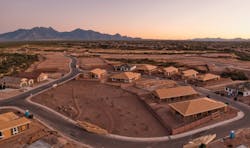What Will It Take to Resolve a Housing Deficit of 4.3 Million Homes?
Rising affordability challenges in the housing sector continue to highlight the severity of a mounting supply deficit, one which is exasperated by a steep uptick in household formation. While the nation’s housing stock grew by roughly 6.3 million housing units from 2015 to 2021, the total number of families living in the United States increased by 7.9 million, and 7.1 million new households were formed during that same period, according to Zillow.
To meet current demand for housing, the U.S. needs to build back from a deficit of 4.3 million housing units, but as costs for building materials rise and labor remains in short supply, resolving that shortage is going to require additional funding and major policy reform.
Some steps in the right direction include zoning reforms to allow for more housing units as opposed to just single family detached homes. This alone would create millions of critically needed new housing units and surveys show most residents would support such changes in their own neighborhoods to increase supply. More steps, such as eliminating or reducing parking requirements, minimizing building permit approval delays, establishing and expanding affordable housing trust funds should also be explored. Ultimately, developers need to be at the forefront of new home construction in order to meet the demand that exists in every part of the housing market.
